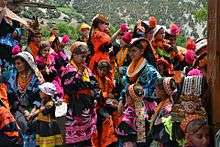Dards
 Kalash in traditional dress | |
| Regions with significant populations | |
|---|---|
|
Gilgit–Baltistan (Pakistan) Khyber Pakhtunkhwa (Pakistan) Jammu and Kashmir (India) | |
| Languages | |
| Dardic languages | |
| Religion | |
| majority Islam (Sunni, Shia, & Sofia Noorbakhshia), minority Hinduism, Kalash and Buddhism | |
| Related ethnic groups | |
| Nuristani people |
The Dards are an Indo-Aryan ethnic group found predominantly in northern Pakistan, north-west India, and eastern Afghanistan. They speak the Dardic languages, which belong to the Indo-Aryan family. The largest populations are in Gilgit–Baltistan and Khyber Pakhtunkhwa, Pakistan and in Kashmir, India. There are smaller populations in Ladakh, India and eastern Afghanistan.[1] The Kashmiri people are the largest group, with a population of over 5.5 million.[2]
History
Parpola identifies "Proto-Dardic" with "Proto-Rigvedic", suggesting that the Dards are the linguistic descendants of the bearers of proto Rigvedic culture ca. 1700 BC, pointing to features in certain Dardic dialects that continue peculiarities of Rigvedic Sanskrit, such as the gerund in -tvī.[3]
During Swati rule, the Dard people predominantly followed a form of ancient Hinduism and "frequent small-scale jihad against Dards might have been a routine".[4][5]
Religion
The vast majority of Dardic peoples are Muslim. They follow a number of different sects. The Kashmiri, Pashayi, Kohistani, and Kho peoples are majority Sunni, while the Shina and Burusho peoples are majority Shia Ismaili and Twelver. Some in Gilgit-Baltistan follow Sofia Noorbakhshia, a Sufi order. The Kashmiri Pandits are Hindu, mostly of the Saivaite sect.[6]
A minority in Chitral are polytheistic Kalash.[4][7] They are exceptional in having retained their ancestral polytheistic Dardic religion and are officially protected by the Government of Pakistan.
The Brokpa of Ladakh are nominally Buddhists. However, they still retain marked traces of their pre-Buddhist animistic religion, Bon-chos.[7]
Social status
As of 2001, the Brokpa were classified as a Scheduled Tribe under the Indian government's reservation program of positive discrimination.[1]
See also
References
- 1 2 "List of Scheduled Tribes". Census of India: Government of India. 7 March 2007. Retrieved 27 November 2012.
- ↑ http://www.ethnologue.com/language/kas
- ↑ Parpola, Asko (1999). "The formation of the Aryan branch of Indo-European". In Roger Blench; Matthew Spriggs. Archaeology and Language III: Artefacts, Languages and Texts. Routledge. p. 189. ISBN 978-1-134-85585-8.
- 1 2 "Swat: an Afghan society in Pakistan : urbanisation and change in tribal environment". City Press.
During Swati rule Dard people were most probably non-believers and dominantly Hindu, frequent small scale Jihad against Dard might have [been] a routine and probably continued even some time after Yousafzai occupation.
- ↑ Minahan, James B. (10 February 2014). Ethnic Groups of North, East, and Central Asia: An Encyclopedia. ABC-CLIO. p. 205. ISBN 9781610690188.
Living in the high mountain valleys, the Nuristani retained their ancient culture and their religion, a form of ancient Hinduism with many customs and rituals developed locally. Certain deities were revered only by one tribe or community, but one deity was universally worshipped by all Nuristani as the Creator, the Hindu god Yama Raja, called imr'o or imra by the Nuristani tribes. Around 700 CE, Arab invaders swept through the region now known as Afghanistan, destroying or forcibly converting the population to their new Islamic religion. Refugees from the invaders fled into the higher valleys to escape the onslaught. In their mountain strongholds, the Nuristani escaped conversion conversion to Islam and retained their ancient religion and culture. The surrounding Muslim peoples used the name Kafir, meaning "unbeliever" or "infidel," to describe the independent Nuristani tribes and called their highland homeland Kafiristan.
- ↑ Ian Charles Harris (1994). "Longman Guide to Living Religions". Stockton. Retrieved 1 July 2016.
The central philosophy of monistic Shaivism is that there is only one ... the daily lives of the remaining Shaiva brahmins of Kashmir or Kashmiri pandits.
- 1 2 The India magazine of her people and culture, Volume 14. A. H. Advani. Retrieved 2007-08-01.
Dardic religion in Ladakh, particularly in the villages of Da and Hann, retains marked traces of the pre-Buddhist animistic religion, Bon-chos